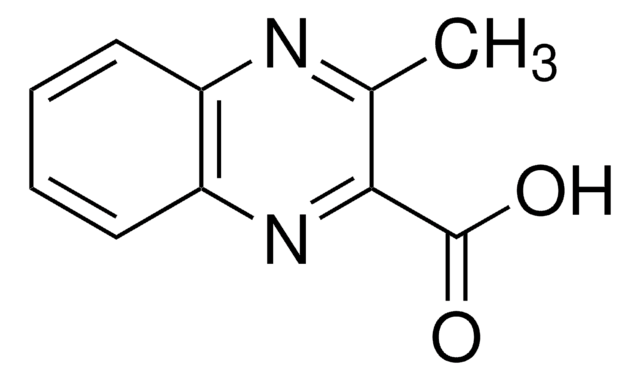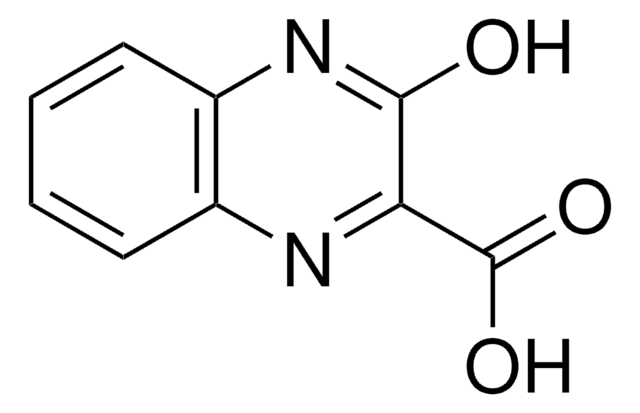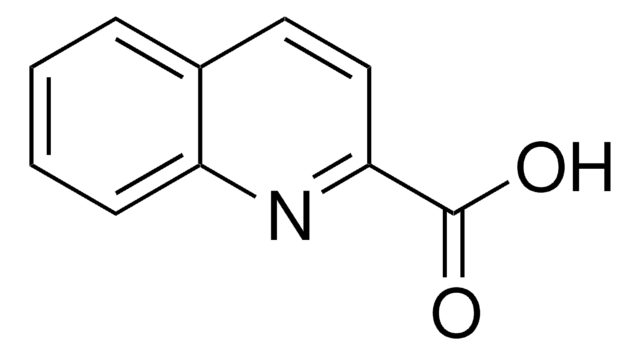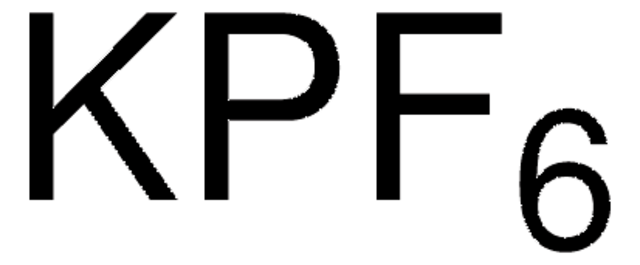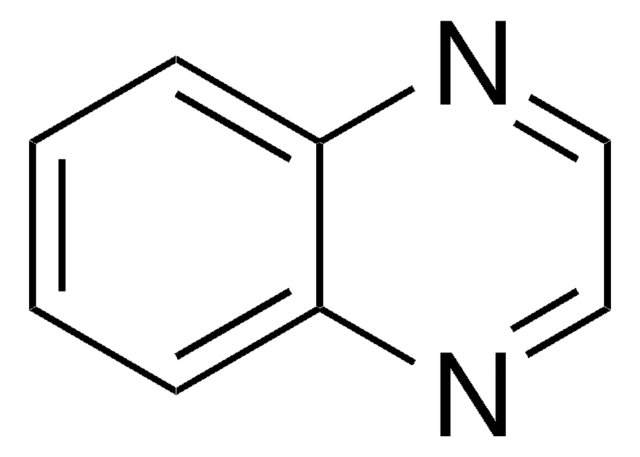293407
2-Quinoxalinecarboxylic acid
97%
Se connecterpour consulter vos tarifs contractuels et ceux de votre entreprise/organisme
About This Item
Formule empirique (notation de Hill):
C9H6N2O2
Numéro CAS:
Poids moléculaire :
174.16
Numéro MDL:
Code UNSPSC :
12352100
ID de substance PubChem :
Nomenclature NACRES :
NA.22
Produits recommandés
Essai
97%
Pf
208 °C (dec.) (lit.)
Groupe fonctionnel
carboxylic acid
Chaîne SMILES
OC(=O)c1cnc2ccccc2n1
InChI
1S/C9H6N2O2/c12-9(13)8-5-10-6-3-1-2-4-7(6)11-8/h1-5H,(H,12,13)
Clé InChI
UPUZGXILYFKSGE-UHFFFAOYSA-N
Description générale
Linear and Freundlich adsorption isotherm coefficient of 2-quinoxalinecarboxylic acid has been evaluated.
Application
2-Quinoxalinecarboxylic acid has been used in the preparation of:
- N-(2-quinoxaloyl)-α-amino acids
- bisquinoxaloyl (bisquinoxalinecarbonyl) derivatives
Mention d'avertissement
Warning
Mentions de danger
Conseils de prudence
Classification des risques
Eye Irrit. 2 - Skin Irrit. 2 - STOT SE 3
Organes cibles
Respiratory system
Code de la classe de stockage
11 - Combustible Solids
Classe de danger pour l'eau (WGK)
WGK 3
Point d'éclair (°F)
Not applicable
Point d'éclair (°C)
Not applicable
Équipement de protection individuelle
dust mask type N95 (US), Eyeshields, Gloves
Faites votre choix parmi les versions les plus récentes :
Déjà en possession de ce produit ?
Retrouvez la documentation relative aux produits que vous avez récemment achetés dans la Bibliothèque de documents.
M D Rose et al.
Food additives and contaminants, 12(2), 177-183 (1995-03-01)
A method for the determination of residues of quinoxaline-2-carboxylic acid (QCA), the major metabolite of carbadox, in pig kidney has been developed. Tissue samples were subjected to alkaline hydrolysis, liquid-liquid extractions, ion-exchange chromatography and further extraction to concentrate the analyte
Yukun Yang et al.
Biosensors & bioelectronics, 47, 475-481 (2013-04-30)
Quinoxaline-2-carboxylic acid (QCA) is difficult to measure since only trace levels are present in commercial meat products. In this study, a rapid, sensitive and selective molecularly imprinted electrochemical sensor for QCA determination was successfully constructed by combination of a novel
Yujie Wu et al.
Journal of chromatography. A, 1146(1), 1-7 (2007-03-06)
A method of high-performance liquid chromatography with UV detection has been established for simultaneous quantitative determination of quinoxaline-2-carboxylic acid (QCA) and methyl-3-quinoxaline-2-carboxylic acid (MQCA), the marker residues for carbadox (CBX) and olaquindox (OLA), respectively, in the muscles and livers of
N Prabavathi et al.
Spectrochimica acta. Part A, Molecular and biomolecular spectroscopy, 92, 325-335 (2012-03-27)
The FTIR and FT-Raman spectra of 2-quinoxaline carboxylic acid (2-QCA) has been recorded in the region 4000-450 and 4000-100 cm(-1), respectively. The conformational analysis, optimized geometry, frequency and intensity of the vibrational bands of 2-QCA were obtained by the density
Dapeng Peng et al.
Food chemistry, 237, 290-296 (2017-08-03)
An immunoaffinity column (IAC) for the selective purification of 3-methyl-quinoxaline-2-carboxylic acid (MQCA) from porcine muscle and the liver as well as the methods for its determination by high-performance liquid chromatography with ultraviolet detection (HPLC-UV) and a colloidal gold-based immunochromatographic assay
Notre équipe de scientifiques dispose d'une expérience dans tous les secteurs de la recherche, notamment en sciences de la vie, science des matériaux, synthèse chimique, chromatographie, analyse et dans de nombreux autres domaines..
Contacter notre Service technique